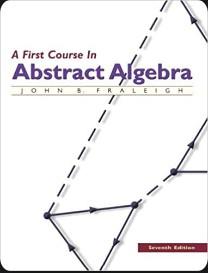Complete the proof of Theorem 14.4 by showing that if H is a subgroup of a group
Question:
Complete the proof of Theorem 14.4 by showing that if H is a subgroup of a group G and if left coset multiplication (aH)(bH) = (ab)H is well defined, then Ha ⊆ aH.
Data from Theorem 14.4
Let H be a subgroup of a group G. Then left coset multiplication is well defined by the equation
(aH)(bH) = (ab)H
if and only if H is a normal subgroup of G.
Proof: Suppose first that (aH)(bH) = (ab)H does give a well-defined binary operation on left cosets. Let a ∈ G. We want to show that aH and Ha are the same set. We use the standard technique of showing that each is a subset of the other.
Let x∈ aH. Choosing representatives x ∈ aH and a-1∈ a-1 H, we have (xH)(a-1H) = (xa-1)H. On the other hand, choosing representatives a ∈ aH and a-1 ∈ a-1 H, we see that (aH)(a-1H) = eH = H. Using our assumption that left coset multiplication by representatives is well defined, we must have xa-1 = h ∈ H. Then x = ha, so x ∈ Ha and aH ⊆ Ha.
We tum now to the converse: If His a normal subgroup, then left coset multiplication by representatives is well-defined. Due to our hypothesis, we can simply say cosets, omitting left and right. Suppose we wish to compute (aH)(bH). Choosing a ∈ aH and b ∈ bH, we obtain the coset (ab)H. Choosing different representatives ah1 ∈ aH and bh2 ∈ bH, we obtain the coset ah1bh2H. We must show that these are the same coset. Now h1b ∈ Hb = bH, so h1b = bh3 for some h3 ∈ H.
Thus (ah1)(bh2) = a(h1b)h2 = a(bh3)h2 = (ab)(h3h2)
Step by Step Answer:






